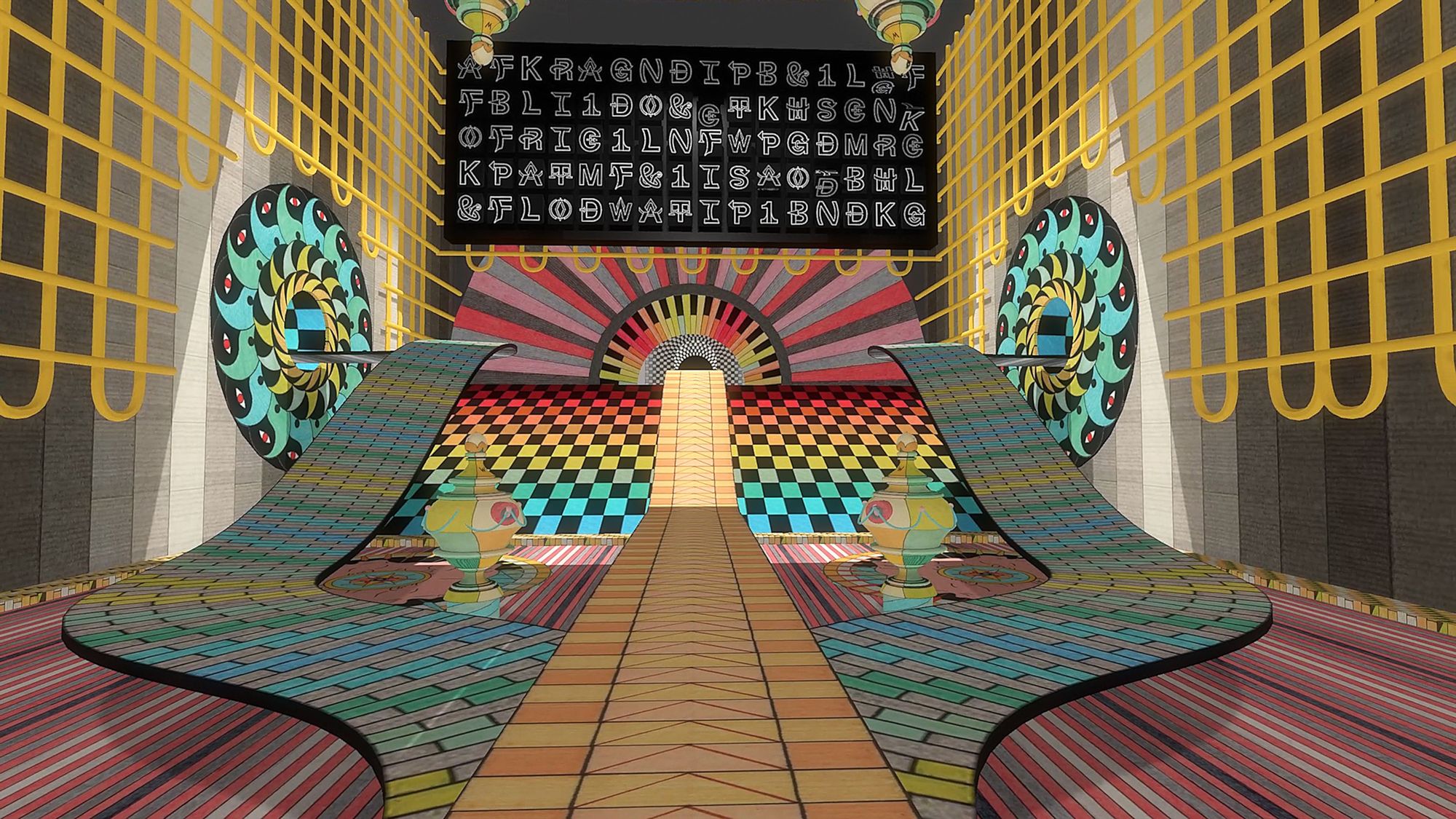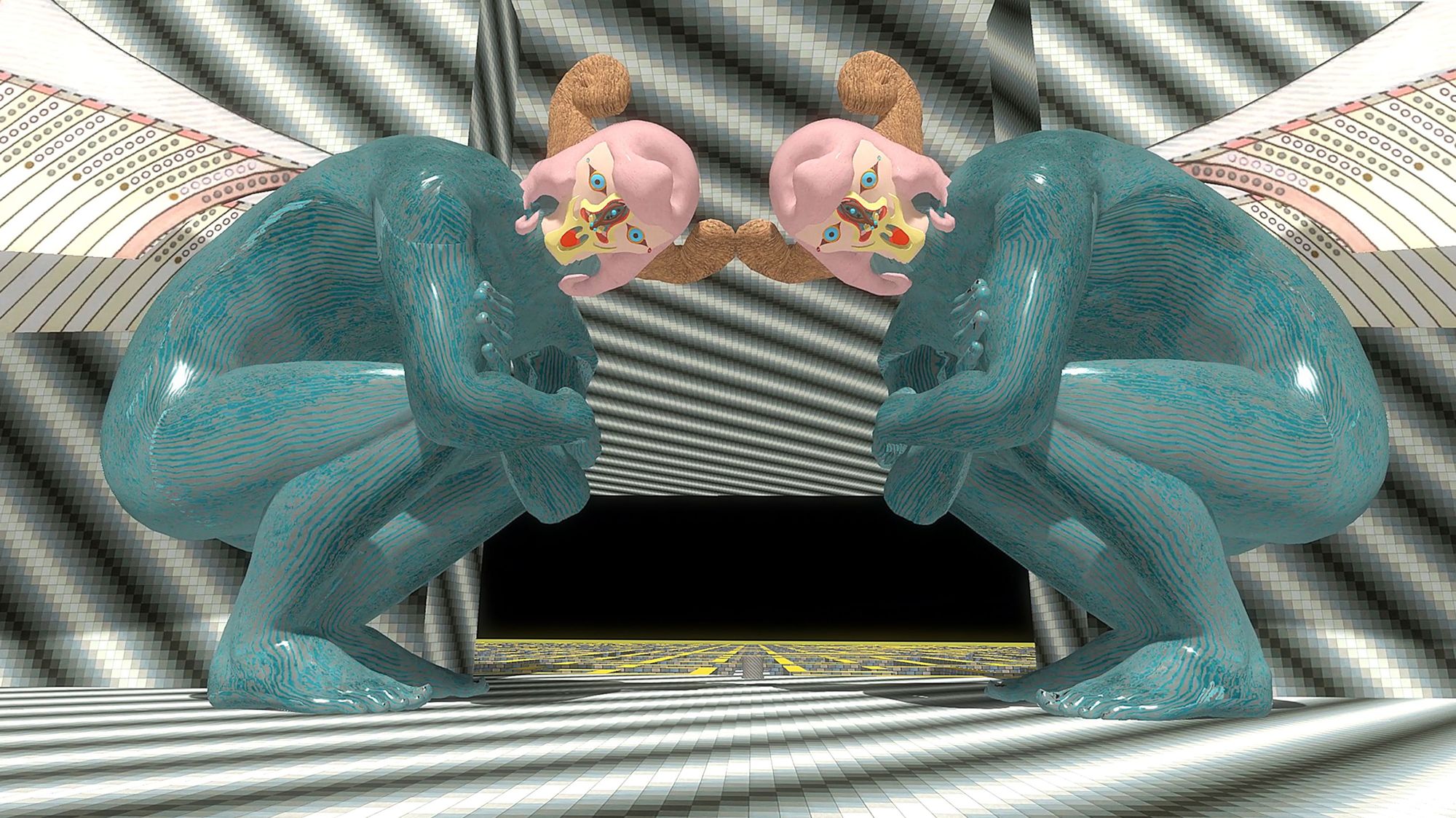Fleshold Crossing
TERMINUS presents a quest, a choose-your-own adventure into a mysterious universe of alien architecture populated by humanoid clones and cryptic symbols. Prepare yourself for a slippage of time and space as your journey propels you across five distinct realms: cross the frontier through Fleshold Crossing; take respite in Known Unknown; lose yourself within Scumm Engine; face impending danger in the tower of Gog & Magog; and experience the brink of sensory overload in the psychedelic Tumblewych. The mysteries of what you ultimately seek will be revealed: an understanding that reality is not fixed but rather both malleable and multiple.
Escape to Fleshold Crossing and enter into a new, mind-bending world from the comfort of your couch with this immersive 360-degree video. If you chose to enter back into the real world afterwards, enjoy Tommy Martinez’s interview with creators Jess Johnson and Simon Ward, the first in our series that center around remote collaboration and coworking, which you can find below.
What is TERMINUS? How did it begin?
TERMINUS is a Virtual Reality experience in five parts. At its core, TERMINUS presents a quest, a choose-your-own adventure into a mysterious universe of alien architecture populated by humanoid clones and cryptic symbols. I’ve been drawing the world of Terminus by hand for over a decade now. These drawings are brought to life by my long term collaborator Simon Ward and developer Kenny Smith, and enriched with soundtracks by composer Andrew Clarke. TERMINUS was initially commissioned by the National Gallery of Australia in 2018, and exhibited within a huge immersive installation which included a sprawling tessellated floor map and modular structures. The larger installation experience is currently on a two year tour of exhibition venues around Australasia, although that has been abruptly halted due to COVID-19.
How do you and your partner or team organize new thoughts and ideas?
We get ideas for new work during the rare times Simon and I are able to share actual physical space together. We live in different countries so have had to learn how to work collaboratively and remotely from each other. Our collaboration has been a patchwork of coming together on shared residencies or exhibitions, where we have these hothouse periods of streaming far-fetched free-flowing ideas at each other. This is followed by long periods of remote working and refinement where we are in constant contact on WhatsApp, video chat or meeting in our VR headsets. We have a lot of autonomy or creative freedom in our separate areas so collaborating remotely from each other hasn’t been difficult for us.
I think it all works because we are both solitary in our respective areas so enjoy being able to go back into our work holes after sharing time together. I like to spend all day drawing and not talking to anyone. Simon likes to spend all day in front of a screen only talking in online chat form. We also share similar backgrounds of growing up in small-town New Zealand in the 80s. I think this has given us a shared sensibility and reference points in popular culture, which connects our aesthetics and world view and we generally find ourselves naturally on the same page with most things.

How do you share progress, review items and give feedback?
The time difference between NZ and New York is a bit tricky, just when I'm waking up in the morning, Jess will be just finishing for the day and vice versa. We tend to send emails with things to be looked at a convenient time for the other. I usually hassle Jess with a million whatsapp messages every day with images that pop up in my blog feed, small questions and off the subject ranting. These are looked at when Jess comes up for air from the drawing desk. The drawing process requires a bit of immersion on her part, so I try not to interrupt too much with the messages, but I'm still a bit trigger happy to be honest.
During the period we were making the TERMINUS VR work we’d meet up in VR in various multiplayer applications to discuss things, mostly using Bigscreen, where we could sit in a virtual movie theater and have our computer’s desktop projected onto the cinema screen. I could do adjustments in the unity app projected onto the screen while we were in the theater and we could discuss changes etc. We found working like this more natural for communication than video calling. Even though we were only represented by a low poly avatar, and only hands and head/torso, you get a sense of being inhabiting the same environment as someone else. Maybe it's the combo of voice plus natural movements of the motion tracked hands and head that gives this feeling. A habitual part of the Bigscreen process would be to make sure our virtual avatar had the appropriate cyber punk look too, which usually took up a good chunk of the meeting time [laughs]. We’d also meet in multiplayer games like Echo Arena, where you can play Tron-style future sports while floating around within a more developed robot avatar. We’re both quite uncoordinated so we didn't get much further than the multiplayer lobby zone and were regularly interrupted by passing ten-year-olds asking what we were talking about. We also tried out the karaoke zone in Rec Room.
How has the current crisis affected that process?
Well. COVID-19 did put a big spanner in the works. Simon had actually just arrived in New York from New Zealand right before everything started to escalate. The timing was somewhat ridiculous because he had been trying to get to the United States for a very long time but kept getting his Visa application knocked back. Finally, earlier this year he was granted a visa so we could show Terminus at the SXSW festival in Austin, Texas. But the day before I was due to leave for Texas to meet Simon we found out the festival was cancelled due to the virus. Simon changed his flight to come to New York instead and we planned to make the most of our time together hanging out and getting ideas down for this animated short film we are making. Anyway the day after he arrived everything started to get crazy and he understandably got very nervous about being able to get back to New Zealand before the flights stopped and borders shut. So we spent a week cooped up in my apartment in Redhook trying to storyboard a short film in between obsessively checking the news like everyone else. Now he’s back in New Zealand living in self isolation, and I’m still in New York; and we’re working together on opposite sides of the world as we are rather accustomed to doing.
I still believe that sharing physical space is the most conducive to getting us enthusiastic and bouncing ideas around, so it is a loss that we didn’t get more time together. At least we made a lot of progress in the week we spent housebound so we’re fortunate to have had that.

What have been the greatest challenges for you and what new creative space has this created if any?
The greatest challenge for me is dealing with the administrative or non-creative aspects that arise as our projects become more ambitious: the time spent scheduling and emailing, navigating time zone differences and budgets, etc. That all takes time away from actually drawing, which is what I prefer doing over anything else in the world. There’s also a supply chain to the whole thing and my drawings are the building blocks. So in one way the collaborations and bigger projects expand the world but they also slow a certain part of the process, which is sometimes frustrating. However the benefits of working with Simon and our wider team is that my world gets filtered through the imaginations and creativity of other people, and therefore it expands the universe in ways I couldn’t do on my own. It’s actually a relief for me to relinquish control of the world; otherwise I’d just be its tyrannical dictator and it would remain stagnant. I want it to move into territories which I would not have thought of and which I have no control over. What Simon creates in the world feeds back into what I do; and that back and forth has a generative and propulsive effect.
TERMINUS draws on sci-fi/horror literature and movies. I've been feeling like I'm living in a Ballard story the past few weeks, what can we learn from representations of other worlds?
The books and films I consumed as a kid were incredibly important in opening up the world to me. Growing up in a little beachside town, pre-internet in New Zealand was idyllic in all the ways you can imagine. But it also engendered a huge curiosity for worlds outside my own very small one. So I was super hungry for these incredibly detailed imaginary worlds that were revealed to me in books and movies, and I gravitated towards the stuff that was as far removed from my reality as possible. I can draw a direct line between the art I make now and the desire I had as a kid for discovering something ‘more’ to the world than what surrounded me. I feel that having this imagination is incredibly important to us as social and political animals. If we can imagine other worlds then that’s the first step to imagining a different world then the one we’re currently living in. If our imagination is killed then the potential for change dies as well.
Subscribe to Broadcast